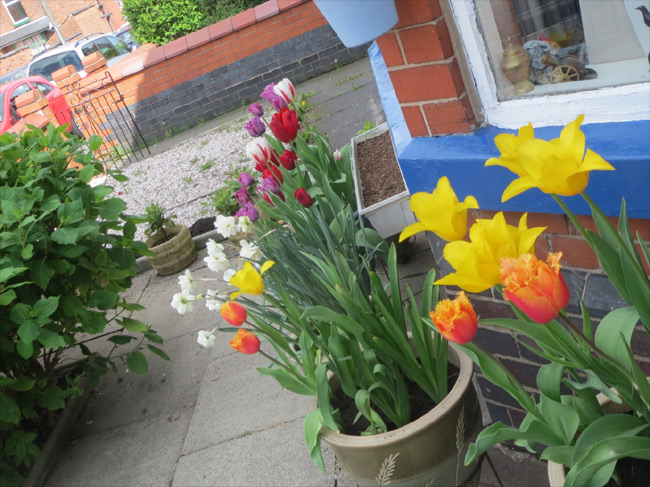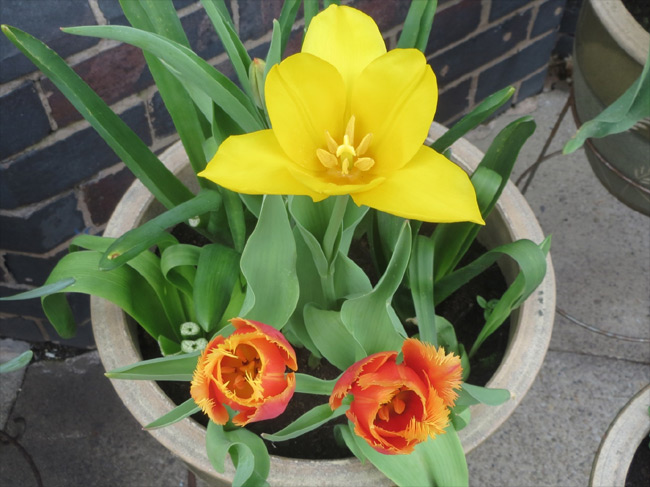
| HOME |
| NERVE |
| REVIEWS |
| ARCHIVE |
| EVENTS |
| LINKS |
| ABOUT US |
| CONTRIBUTORS |
| BACK ISSUES |
| CONTACT US |
Fireweed*
By Sandra
Gibson
Photographs by Geoff Edwards
Putting on a Front
September 2014
When a Member of Parliament claimed expenses for the maintenance of his moat we ordinary folk were scandalised, partly because such considerations belong in the mediaeval backwoods of hierarchical dominance. Yet we all have a version of the moat - in most cases it’s our front garden and it represents a protective buffer between our ‘castle’ home and the badland wastes beyond our gate. My father has had a decades-old feud with the distributors of pizza publicity, who always leave his front gate open. Prospective political candidates please take note: Mr Gibson will vote for you, whatever colour your rosette, if only you will close his gate when you leave. It’s as good an indication of vote-worthiness as any other; many people would be impressed by a person who understands gateway etiquette.
 |
These primitive instincts to protect the cave notwithstanding, the front garden has other sociological functions. For example, it presents a face or a façade to the world indicating the social aspirations, and level of tidiness - or slovenliness - of the occupants. Not having a front garden to express her prowess as a respectable housewife, my mother directed her attention to the front step which had to be whitened every day if standards were to be maintained. This pristine step was the symbol of excellence in a town where most of the male workforce brought in bletch and soot on their boots from places of heavy metallic danger. I suppose the front garden equivalent of the immaculate threshold is the arrangement of symmetrical tubs of plants and high-maintenance hanging baskets around the front door. Daily dead-heading and watering are essential to maintain the perfection to be found in these miniature gardens.
The relatively small size of many front gardens does provide the opportunity to present a little patch of orderliness not easily achieved in the more multi-functional back garden. I remember the post-war gardens of my childhood: the tiny square lawns bordered by red geraniums, blue lobelia and white alyssum, all standing to attention in equidistant alertness and overseen by a standard Queen Elizabeth rose at the centre.
Of course, for every garden on its best behaviour, there are many other front gardens bordering on hooliganism. The most depressing are those where litter has accumulated to the extent that even the tall grass does not conceal its tawdry presence. Yet neglected gardens can be among the best. I lived next door to a front garden which was only attended to once a year - everything stripped out and taken away in bin liners, leaving a few whitened stalks and crumpled leaves: the remains of a wondrous garden of dock leaves. I know why I was so fond of this dishevelled plot: when I stung myself on nettles as a child my granddad used to tell me to fetch a “doctor” leaf. He would rub the stings with the dock leaf and a residue of green would blend with the reddened flesh and the irritation would subside. So I was happy to see the memories grow and grow until the green flowers turned that unique tan colour which dominated the lesser weeds entirely.
The widespread tendency to aspire to an exemplary front garden led to a movement of crusading TV gardeners more at home on a building site than in a pastoral idyll. The theory was that we needed a solution to the front garden issue which would present a positive face to our potential critics whilst not demanding any of our precious time. Hence minimalism: pave or deck the area, leaving one space for an architectural, low maintenance specimen plant or some exotic black grasses. Think Zen garden. Such gardening makeovers were indeed impressive but time always takes its toll and before long the black membranes laid as a base for pebbles raised themselves like a guilty secret, or the ubiquitous weeds ruined the quietly tasteful blue slate by growing … everywhere. The tendency to pave gardens had a further disadvantage: there is now a reduced capacity for absorbing rainwater and this is said to contribute to flooding. A serious outcome.
 |
A more positive trend is the movement to garden in an ecologically friendly way. This has led to people using front gardens, balconies and even planters, to grow their own food and to grow plants that will encourage wildlife to flourish. There are consequences of course. My neighbour has objected to the thickness of my hedge but although I try to keep it from overhanging his garden, I am reluctant to thin it out because the blackbirds live there and what a privilege that is. I have no intention of complaining to him about his nuisance of an elderberry tree because it is so spectacular to see the starlings raiding it that a little juice on the parked cars seems a small price to pay. Doesn’t it?
I’ve been chucking flower seeds in the derelict front gardens of strangers for years. The yellow Welsh poppies that started life in my guardian pots have almost colonised the whole terrace and I’m developing a nasturtium offensive this Autumn - just waiting for my sister-in-law to finish knitting my balaclava and for the nights to draw in a bit more.
To read other Fireweed columns click here
*Also known as Rose Bay Willow Herb, the prolific wild flower called Fireweed, five feet tall with spikes of magenta flowers, cheers the hearts of those whose cityscape has become a bomb site or whose buildings have been cleared by machine. The dormant seeds spring to life after destructive events such as forest or man-made fires, hence the name, Fireweed. This occasional column will celebrate the persistence of wildlife in urban conditions.